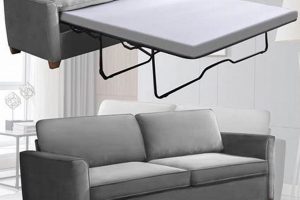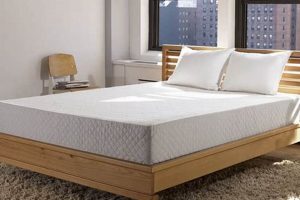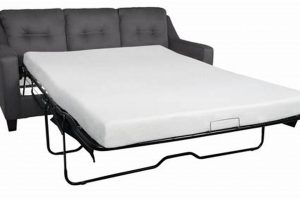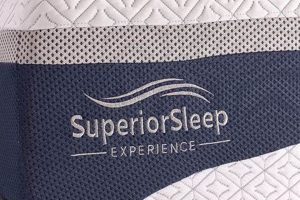The item in question is a specially designed sleeping surface intended for infants in the first weeks and months of life. It offers a safe and supportive environment for newborns during their extended periods of rest. These products are typically constructed with specific dimensions and materials to meet safety standards and promote healthy infant development. As an example, consider a firm, flat surface designed to fit snugly within a crib or bassinet, preventing gaps where a baby could become entrapped.
The selection of an appropriate sleeping surface for infants is paramount for several reasons. A properly designed product minimizes the risk of Sudden Infant Death Syndrome (SIDS) by ensuring a firm, flat surface that prevents suffocation. Furthermore, the materials used in its construction often prioritize breathability and hypoallergenic properties to reduce the likelihood of allergies or skin irritation. Historically, the understanding of infant sleep safety has evolved, leading to stricter regulations and improved product design focusing on creating the safest possible sleep environment.
Subsequent sections will delve into specific aspects of selecting the ideal product, including safety certifications, material considerations, size and fit within the sleep environment, and proper maintenance to ensure continued safe usage. We will also explore the various types available and provide guidance on recognizing and mitigating potential risks associated with substandard or improperly used items.
Considerations for a Safe Newborn Sleep Environment
The following tips outline critical considerations when selecting and utilizing a suitable sleep surface for newborns, prioritizing safety and optimal infant development.
Tip 1: Verify Safety Certifications: Scrutinize the product for certifications from recognized safety organizations such as the JPMA (Juvenile Products Manufacturers Association) or similar entities in relevant jurisdictions. These certifications indicate that the product has undergone rigorous testing and meets established safety standards.
Tip 2: Prioritize Firmness: The sleeping surface must be sufficiently firm to prevent indentation or molding to the infant’s shape. A soft surface poses a suffocation hazard. Test the firmness by pressing on the surface; it should offer minimal give.
Tip 3: Ensure Proper Fit: The chosen product should fit snugly within the crib or bassinet frame, leaving no gaps that could entrap the infant. Measure the interior dimensions of the crib and compare them to the dimensions of the sleeping surface before purchase.
Tip 4: Select Breathable Materials: Opt for materials that promote airflow and minimize the risk of overheating. Breathable covers and internal structures can contribute to a more comfortable and safer sleep environment.
Tip 5: Avoid Excessive Bedding: Refrain from using excessive blankets, pillows, or stuffed animals within the sleep environment. These items increase the risk of suffocation and are not recommended for newborn sleep safety.
Tip 6: Regularly Inspect for Damage: Routinely inspect the product for any signs of wear and tear, such as tears in the cover, sagging, or compromised structural integrity. Replace the product if any damage is detected.
Tip 7: Maintain a Clean Surface: Regularly clean the sleeping surface according to the manufacturer’s instructions. This helps prevent the build-up of allergens and bacteria, contributing to a healthier sleep environment.
Adherence to these guidelines significantly reduces the risks associated with infant sleep and promotes a safer, more conducive environment for healthy development.
The subsequent sections will provide detailed information on specific types of infant sleeping surfaces and address common misconceptions regarding infant sleep safety practices.
1. Firmness
The firmness of a newborn sleep mattress is a non-negotiable safety requirement. A soft surface can conform to the infant’s face, creating a pocket that obstructs breathing and elevates the risk of suffocation. This adverse effect is a primary contributor to Sudden Infant Death Syndrome (SIDS). Conversely, a sufficiently firm surface maintains its shape, preventing the infant from sinking into it and ensuring an open airway. The material composition and construction techniques directly influence the degree of firmness achieved. For example, mattresses utilizing high-density foam or innerspring systems are generally firmer than those made with less rigid materials. The choice of materials and construction directly impacts the safety profile of the sleep surface.
Real-world examples underscore the critical importance of firmness. Numerous studies have demonstrated a correlation between softer sleeping surfaces and increased SIDS risk. Public health campaigns consistently emphasize the “Bare is Best” principle, advocating for a firm, flat sleep surface free from loose bedding or soft objects. Regulatory bodies, such as the Consumer Product Safety Commission (CPSC), have established mandatory safety standards for crib mattresses, including minimum firmness requirements. These regulations are a direct response to the documented dangers of soft sleeping surfaces and aim to protect vulnerable infants.
In summary, the firmness of a newborn sleep mattress is a fundamental element in preventing suffocation and reducing SIDS risk. Selecting a product that meets established safety standards for firmness is paramount. While a comfortable sleep environment is desirable, safety considerations must take precedence. Further research into material science and construction techniques can continue to refine mattress designs, enhancing both safety and comfort for newborns, though the unwavering principle of firmness must remain at the core of all designs.
2. Dimensions
The dimensions of a newborn sleep mattress are critically important due to their direct impact on infant safety within the sleep environment. The dimensions of the mattress dictate how well it fits within a crib or bassinet. An improperly sized mattress can create gaps between the mattress and the crib walls, presenting a significant entrapment hazard. Infants can become wedged in these spaces, leading to suffocation or serious injury. Standardized dimensions, therefore, exist to minimize this risk, ensuring a snug and secure fit. These dimensions are not arbitrary; they are carefully considered to align with established crib and bassinet sizes.
Real-world examples highlight the potential consequences of dimension mismatch. News reports often detail instances where infants have suffered injuries or fatalities due to being trapped in gaps created by ill-fitting mattresses. These incidents underscore the practical significance of adhering to recommended dimensions. Furthermore, manufacturers are obligated to comply with regulatory standards that specify acceptable dimensional tolerances. Compliance with these standards provides assurance that the mattress will fit safely within a compatible crib. The cause and effect relationship is clear: improper dimensions lead to increased risk, while accurate dimensions promote a safer sleep environment.
In summary, understanding the dimensions of a newborn sleep mattress is paramount for preventing entrapment hazards. Manufacturers, retailers, and caregivers must prioritize compliance with established size standards and diligently verify that the mattress fits securely within the intended crib or bassinet. While variations in crib and bassinet designs exist, selecting a mattress with dimensions appropriate for the specific model is essential. This understanding contributes directly to creating a safer sleep environment for newborns, mitigating the risk of preventable injuries or fatalities.
3. Materials
The selection of materials in a newborn sleep mattress directly impacts infant safety and health. Materials dictate the mattress’s firmness, breathability, and potential for off-gassing or allergen release. A mattress utilizing low-density foam may lack the required firmness, increasing suffocation risk. Conversely, a mattress with breathable materials promotes airflow, reducing the risk of overheating, a known SIDS risk factor. The presence of phthalates, flame retardants, or volatile organic compounds (VOCs) in the materials may cause respiratory irritation or other adverse health effects in vulnerable newborns. Therefore, material selection represents a cause-and-effect relationship: the material composition directly influences the infant’s immediate environment and potential long-term health.
Consider the practical example of organic cotton versus conventional cotton. Organic cotton mattresses eliminate exposure to pesticides and herbicides used in conventional cotton farming, minimizing the risk of skin irritation or allergic reactions. Similarly, mattresses utilizing plant-based foams or natural latex may be preferable to those made with petroleum-based polyurethane foam, reducing VOC emissions. Furthermore, the mattress cover material impacts cleanability. A waterproof cover made of polyethylene is easier to sanitize than a fabric cover, preventing bacterial growth and allergen accumulation. Real-world consumer reports often highlight the importance of material transparency, with parents actively seeking mattresses certified by organizations like GOTS (Global Organic Textile Standard) or CertiPUR-US, indicating adherence to stringent material safety standards.
In conclusion, a comprehensive understanding of mattress materials is essential for informed decision-making. While cost and convenience may influence purchasing decisions, prioritizing materials that ensure firmness, breathability, and low toxicity is paramount. Challenges remain in balancing safety, affordability, and environmental sustainability in mattress design and manufacturing. However, continued research into innovative materials and improved transparency in labeling practices will ultimately contribute to creating safer and healthier sleep environments for newborns.
4. Breathability
Breathability, in the context of a newborn sleep mattress, is a critical safety parameter dictating the degree to which air can circulate through the mattress’s materials. Insufficient breathability can lead to localized carbon dioxide build-up around the infant’s face if the infant rolls over onto the mattress, potentially increasing the risk of suffocation. Furthermore, inadequate ventilation can contribute to overheating, a known risk factor for Sudden Infant Death Syndrome (SIDS). Therefore, the breathability of the mattress functions as a crucial mitigating factor against these hazards, establishing a direct causal link between breathability and infant safety.
Mattress construction and material selection significantly impact breathability. Mattresses constructed with open-cell foam structures or containing integrated ventilation channels promote airflow more effectively than those with closed-cell foam or tightly woven covers. Materials such as organic cotton, wool, or breathable mesh contribute to enhanced ventilation compared to synthetic fabrics like vinyl. For instance, a mattress employing a spacer fabric cover allows for constant air circulation, even when compressed by the infant’s weight. Independent testing and certifications, such as those from Oeko-Tex, provide assurances regarding material breathability and absence of harmful substances that could impede airflow. The practical application of this understanding involves carefully scrutinizing mattress specifications and certifications to ensure adequate breathability.
In summary, prioritizing breathability in the selection of a newborn sleep mattress is essential for minimizing suffocation and overheating risks. While advancements in material science continue to improve breathability in mattress design, awareness of material properties and verification of relevant certifications remain crucial. The challenges involve balancing breathability with other desirable mattress characteristics, such as firmness and cleanability. However, maintaining a commitment to maximizing breathability through informed material choices and innovative design strategies is paramount for enhancing infant sleep safety.
5. Certifications
Certifications represent an objective validation of a newborn sleep mattress’s safety and performance characteristics. These certifications, issued by independent testing organizations, attest to the product’s adherence to specific safety standards regarding flammability, chemical emissions, structural integrity, and material composition. Without certifications, claims of safety are unsubstantiated, leaving consumers vulnerable to potentially hazardous products. A certification mark on a mattress provides assurance that the product has undergone rigorous testing, reducing the likelihood of exposing infants to unsafe conditions. The cause-and-effect relationship is direct: compliant design leads to certification, and certification increases consumer confidence in the product’s safety profile.
Real-world examples demonstrate the practical significance of certifications. The Consumer Product Safety Commission (CPSC) mandates specific safety standards for crib mattresses, and certifications from organizations like JPMA (Juvenile Products Manufacturers Association) indicate compliance with these regulations. Mattresses lacking such certifications may contain harmful chemicals or fail to meet flammability requirements, posing a direct threat to infant health and safety. Furthermore, certifications such as GREENGUARD Gold ensure that the mattress meets stringent criteria for low chemical emissions, minimizing the risk of respiratory irritation. Parents often rely on these certifications to make informed purchasing decisions, prioritizing products that offer verifiable safety assurances. Thus, these certifications are important components in the ecosystem of “newborn sleep mattress”
In summary, certifications play a crucial role in ensuring the safety and quality of newborn sleep mattresses. These independent validations provide tangible evidence of a product’s compliance with established safety standards. While certifications are not a guarantee of absolute safety, they significantly reduce the risk of exposure to hazardous materials and unsafe design features. Challenges remain in ensuring consistent enforcement of certification standards and promoting consumer awareness of their importance. However, continued emphasis on robust certification programs will contribute to creating safer sleep environments for newborns.
6. Cleanability
Cleanability is a paramount consideration in the selection and maintenance of a newborn sleep mattress. The sleep environment for infants is susceptible to various contaminants, necessitating a surface that can be effectively and safely cleaned. The ability to thoroughly remove bodily fluids, allergens, and microorganisms from the mattress is critical for maintaining a hygienic sleep space and promoting infant health.
- Surface Material and Impermeability
The surface material of the mattress directly impacts its cleanability. Impermeable surfaces, such as those constructed from polyethylene or treated fabrics, prevent fluids from penetrating the mattress core, minimizing the risk of bacterial growth and odor retention. Conversely, permeable surfaces, such as untreated cotton, readily absorb liquids, creating a breeding ground for microorganisms. Real-world examples include mattresses with waterproof covers that can be easily wiped clean following diaper leaks or spit-up incidents. The selection of a mattress with an impermeable and easily cleanable surface is essential for preventing contamination.
- Disinfectant Compatibility
The ability to safely disinfect the mattress surface is a crucial aspect of cleanability. Certain cleaning agents may damage the mattress material or release harmful chemicals. Mattresses designed for easy cleaning should be compatible with common disinfectants, such as diluted bleach solutions or hydrogen peroxide-based cleaners, without compromising the integrity of the material. For instance, a mattress cover specifically designed to withstand repeated cleaning with disinfectant wipes offers a more hygienic sleep environment compared to one that degrades or discolors with similar treatment. Compliance with manufacturer guidelines regarding appropriate cleaning agents is paramount.
- Removable and Washable Covers
Mattresses with removable and washable covers offer an additional layer of protection and enhance cleanability. A removable cover allows for thorough cleaning and disinfection, while the mattress core remains protected. The ability to machine-wash the cover facilitates the removal of allergens and microorganisms that may accumulate over time. For example, a mattress with a zippered, removable cover that can be laundered in hot water offers a more effective cleaning solution compared to a mattress with a non-removable cover that can only be spot-cleaned. Routine washing of the cover contributes significantly to maintaining a hygienic sleep environment.
- Seam Construction and Liquid Penetration
The seam construction of the mattress cover influences the likelihood of liquid penetration. Poorly constructed seams can allow fluids to seep into the mattress core, even with an impermeable surface material. Reinforced or welded seams minimize this risk, providing a more effective barrier against contamination. For instance, a mattress with heat-sealed seams around the edges offers superior protection against liquid penetration compared to one with loosely stitched seams. Attention to seam construction is an important factor in ensuring the overall cleanability and hygiene of the mattress.
These facets of cleanability are integral to the safe and healthy use of a newborn sleep mattress. The selection of a mattress with appropriate surface materials, disinfectant compatibility, removable covers, and robust seam construction minimizes the risk of contamination and promotes a hygienic sleep environment for infants. Regular cleaning and maintenance, following manufacturer guidelines, are essential for ensuring the continued effectiveness of these features.
Frequently Asked Questions
The following addresses common inquiries regarding the selection and use of sleeping surfaces specifically designed for newborn infants.
Question 1: What level of firmness is appropriate for a newborn sleep mattress?
A newborn sleep mattress must be sufficiently firm to prevent indentation or molding to the infant’s shape. The surface should offer minimal give when pressed, ensuring that the infant’s airway remains unobstructed.
Question 2: What dimensions should a newborn sleep mattress possess?
The dimensions of the mattress must correspond precisely with the interior dimensions of the crib or bassinet. Gaps between the mattress and the crib walls pose a significant entrapment hazard.
Question 3: What materials are considered safe for a newborn sleep mattress?
Materials that promote breathability and are free from harmful chemicals are recommended. Organic cotton, wool, and breathable mesh are often preferred. Certifications such as GOTS and CertiPUR-US provide assurance of material safety.
Question 4: How frequently should a newborn sleep mattress be cleaned?
The mattress should be cleaned promptly following any soiling. Routine cleaning, following manufacturer guidelines, is essential for maintaining a hygienic sleep environment.
Question 5: Are used mattresses appropriate for newborn sleep?
Used mattresses are generally discouraged due to potential hygiene concerns and compromised structural integrity. If a used mattress is employed, it must be thoroughly inspected for damage and cleaned meticulously.
Question 6: What certifications are relevant to newborn sleep mattress safety?
Certifications from organizations such as JPMA, GREENGUARD, and Oeko-Tex provide assurance of compliance with established safety standards regarding flammability, chemical emissions, and material safety.
Selecting an appropriate sleep surface for newborns is a critical decision. Prioritize firmness, proper dimensions, safe materials, and certifications to ensure a safe and healthy sleep environment.
The subsequent section will delve into specific product recommendations and comparisons based on the aforementioned criteria.
Newborn Sleep Mattress
This exploration of the newborn sleep mattress underscores its crucial role in ensuring infant safety and promoting healthy development. Key considerations include firmness to mitigate suffocation risk, precise dimensions to prevent entrapment, and the use of non-toxic, breathable materials to minimize allergic reactions and overheating. Furthermore, adherence to established safety standards, as verified through independent certifications, is paramount.
The selection of a suitable sleeping surface for newborns demands meticulous attention to detail and a commitment to prioritizing safety over convenience or cost. Given the inherent vulnerability of infants, a proactive approach to creating a secure sleep environment is not merely advisable but essential. Continued research and development in mattress design and material science, coupled with rigorous enforcement of safety regulations, are vital for further enhancing the well-being of newborns during their formative months.







